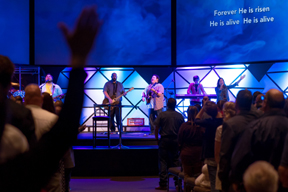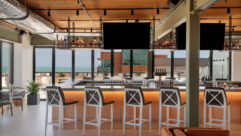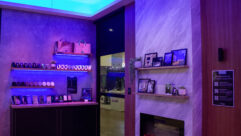
SVC Podcast – Show Notes – Show 160-2
In this edition of the SVC Podcast, SVC Contributing Editor Bennett Liles finishes his conversation with Bill Burke of Ted Brown Music in Richland, Washington about the sound and lighting upgrades he led for the Columbia Community Church. Bill and the church technical director Grant Howard upgraded the front of house sound mixer to a DiGiCo SD9 and added centralized LED lighting control. Bill discusses stage monitoring and tech training at the church.
Links of interest:
Download Podcast Here:
https://s3.amazonaws.com/nb-svc/public/public/Columbia_Community_Church_…
From Sound & Video Contractor Magazine, this is the SVC Podcast with Bill Burke of Ted Brown Music. Show notes and equipment links for the podcast are on the web site of Sound & Video Contractor Magazine at svconline.com.
The Columbia Community Church is growing so fast, the facility itself is trying to keep up with the size of the congregation. Live music carries the message and the new LED lighting sets the stage. Bill Burke is back to tell us about the DiGiCo front of house mixer and lighting for onstage projection at the church. Coming up on the SVC Podcast.
Bill, welcome back. Last week we were talking about the Columbia Community Church in Richland, Washington. They called you in from Ted Brown Music to install or finish some LED lighting and lighting control. It sounds like there’s a lot going on there. How many volunteers do they have for handling the tech side of things?
They run multiple venues and so they typically have somewhere around 20 volunteers, not necessarily all at the same time. But about 20 techs that volunteer at that church.
Since they have live music every week there must be some kind of training involved for the tech people. I’m sure they don’t just turn them loose on all the AV gear.
No. They do some training. One of the things that they handle they have staff that will program, that will do the more technical aspect of it and then a lot of the volunteers are obviously trained on the lighting controller, trained on some of the basics. And then there’s typically staff that roams not only during rehearsals but during services so if there’s issues or questions they can address them at that point. [Timestamp: 1:49]
Okay, some senior guys they can go to if they hit any snags. Give us the layout on this place. Where is the lighting control located? Is that and the front of house mixer located in the same place?
Yeah. They’ve got a control or front of house sound booth area towards the back of the sanctuary, towards the back right-hand side if you’re looking at the stage. And then they also have – located right behind that they have a broadcast room because they do remotes – they broadcast the sermon remotely to other venues and of course recording.[Timestamp: 2:21]
Yeah, with as many new people that they have coming in they would have to get the video and sound to the other spaces in case of an overflow crowd situation. How do they distribute the video? Is it done on CAT6 twisted pair?
Yeah. We’ve ran, as a second part of the project, ran CAT6 to the remote venues from the broadcast room, if you will. And then they of course hit the projectors or the displays in the remote rooms. [Timestamp: 2:46]
Last week we were talking about some of the projection in there. They’ve got big projection screens right over the stage and they’re used quite a bit. Was that a factor in the lighting for it? Did you have to do some things differently to keep from washing out the projection?
Yeah. We’ve got barn doors on all of the fixtures that are mounted on the ceiling and then they’re very careful on their uplighting, not to wash the screen out. We spent quite a bit of time actually aiming the fixtures and that was all with church direction. So it is a priority to ensure that the image quality is represented on the screen and at the same time to have a dynamic worship experience with the lighting. [Timestamp: 3:20]
And you previously upgraded the sound console to a DiGiCo mixer. What model did you put in there for front of house?
We put a DiGiCo SD9 in for front of house. They had a larger format Mackie analog desk in and through a wide variety of conversations we were able to work with them and they decided that the SD9 was the way they wanted to go. [Timestamp: 3:42]
That’s got to make a lot of difference in training the volunteers in the front of house sound.
Yeah. That’s been a conversation. It’s an ongoing conversation. The church does have some staff that’s very technical. They do a very good job. And of course setting up a digital console a lot of the work is in the setup and training the staff on using it and then training the volunteers to use it has been an ongoing consideration. And overall they’ve done a very good job. A couple of noticeable things, the quality of audio was greatly improved and then just the speed and the convenience of using a digital console has made a big difference. Recalling presets of course, using the tools correctly. [Timestamp: 4:22]
Yeah, digital mixers are always great for volunteer environments because you can always push a button and get right back to where you were.
Mm-hmm.
So how do they connect the mixer to the stage sources? How do they get to those sources from the stage?
We took the existing stage boxes and ran them to a new rack that was installed actually underneath the stage to the digital IO for the DiGiCo. And then we ran CAT cable from that up to the front of house. [Timestamp: 4:51]
Once that’s installed I would think it would be a good bit simpler than it was with all the old analog stuff, chasing ground loops and all that.
It definitely cleaned up the system, made it a little bit more convenient for change over and that type of stuff when needed. And overall like I said it’s a very efficient system for them to use. [Timestamp: 5:08]
And with live music being so much a part of their services, how do they handle the stage monitoring?
For the most part they’re all in-ear and if they do require a wedge for some reason they do have a couple of wedges they kept. But in general the entire worship team is on in-ear. [Timestamp: 5:34]
Once they get used to that it’s probably hard for them to imagine how they did it with the floor wedges.
We’ve actually used in-ear at that church for quite some time so they were very familiar with it; again changing to the DiGiCo and just the methodology in the processes cleaned things up considerably and lowered the noise floor quite honestly in the system. So it was as very nice upgrade. [Timestamp: 5:45]
With all of the sound and lighting changes that went into this, did you have to plan for any changes in the electrical system?
Actually no. They had a pretty good infrastructure to begin with and changing to the LED we became just more efficient. We did actually install a couple receptacles in different places but that was more of a convenience than a need. And so overall the system was there it’s just being used more efficiently now. [Timestamp: 6:14]
And what did you do in the other venues surrounding the sanctuary there
Basically outside of running the new CAT cable we didn’t have to do a whole lot of work on this particular part of the project simply based on the fact that one of the venues is fairly new and the work had already been done so the upgrade was planned. We did some lighting in one of the other venues and again that really was just adding to the existing stuff. The church has some very good staff on hand and so they can handle a lot of the plug-and-play stuff. They only call us when they need something more in-depth involved. [Timestamp: 6:49]
And let’s see, your technical director there, that’s Grant Howard?
Grant Howard. Yes.
So obviously he was centrally involved in this project as well.
Yeah. And Grant, he has the vision of what he wants it to look like. He can convey that and he does a really good job using the tools that are provided for him. [Timestamp: 7:06]
I’ve read from several sources that the congregation at Columbia Community Church is rapidly growing. There are some churches now that really seem to be on the accelerator for new members and this looks like one of them. Are there more AV system upgrades planned?
The best way I can say it is the church is constantly upgrading. They are looking at some additional expansion that’s going to be in the near future. Trying to figure out the best way they can use the space they have is probably the forefront of the conversation. In general they’ve been blessed with a lot of growth and it’s double-digit growth but it’s been fairly consistent for quite some time so they’re doing something right. As far as the next stage they’re going to have to add to the building. I’m not sure what they looks like yet, but when they get an idea of what they want to do I hope to be involved in the project and I hope to work alongside them to continue to meet their needs and their congregational needs. [Timestamp: 7:59]
Yeah, they seem to be growing so fast it’s going to be a challenge just physically housing everything they want to do. But you and Grant seem to have them fixed up for now. It’s the Columbia Community Church in Richland, Washington and Bill Burke from Ted Brown Music with new lighting control and front of house sound. It’s been a pleasure having you with us, Bill.
Very good. Again thanks for having us and if we could just end on the note that the important thing is always the message. So whether it’s the worship or it’s the spoken word just remember to keep that as a priority. [Timestamp: 8:26]
Very good. Thanks.
It was great to have you here for the SVC Podcast with Bill Burke. Show notes and equipment links are on the website of Sound & Video Contractor Magazine at svconline.com. Be right here with us every week for the SVC Podcast.










